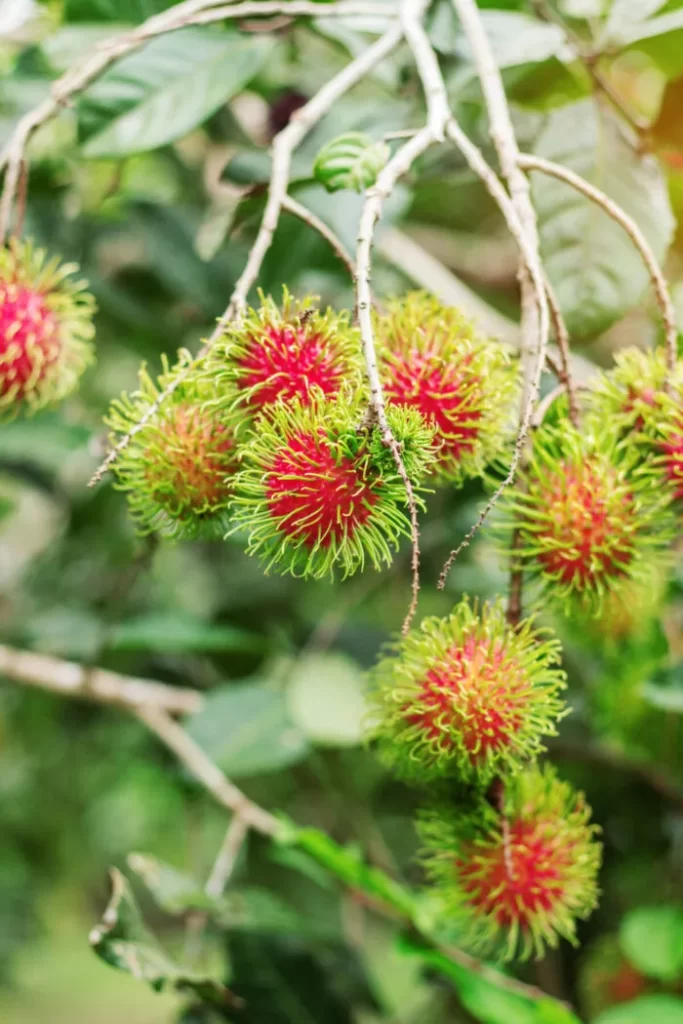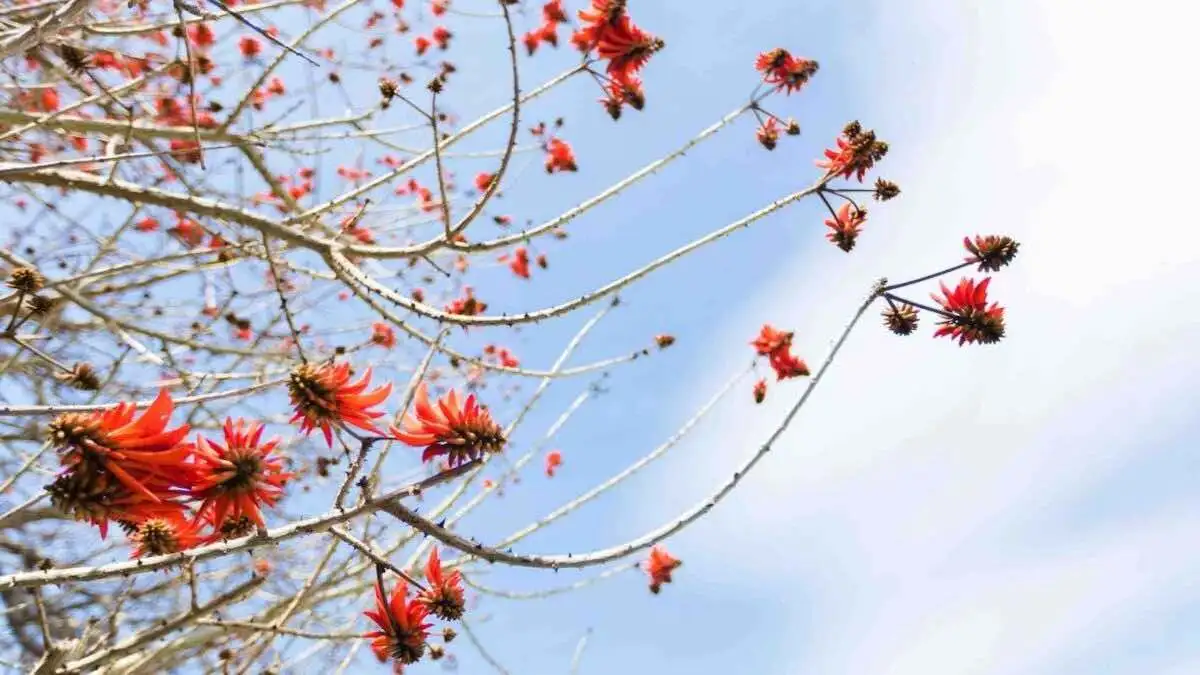Table of contents
Rambutan Tree
Rambutan tree care should see your tree produce fruit with a red spiky exterior and flesh that tastes a little like grapes with a slight strawberry flavour. Indeed the rambutan tree (Nephelium lappacium) is closely related to the lychee and longan. Consequently, the rambutan trees produce red spiky fruit that have lychee like flesh.
The rambutan originated from the Malaysian−Indonesian region. Firstly, they became widely cultivated in other southeast Asia countries, such as Thailand, Myanmar, Sri Lanka, Malaysia, Indonesia, Singapore, and the Philippines. Subsequently, they have spread across the globe.
Rambutan Tree Varieties
More than 50 varieties of the rambutan have been introduced into Northern Australia from Southeast Asian countries. Today around 15 varieties are grown commercially.
In Australia they are grown around the coastal regions in North Queensland and Darwin. The main varieties grown in Australia include Jitlee, R156, R167 and R134.
Propagation
You can propagate this tree from cuttings, seed or by marcot. Propogation by marcot is definitely the way to go.
From Seed
Rambutans grown from seed are not ‘true to type’. Indeed most of these seedlings will develop into male flowering trees. Hence, they do not produce fruit. For this reason we do not grow from seed.
By Marcot
Time needed: 4 minutes
How do I grow rambutan trees by marcot?
- Select the branch you would like to marcot
Choose a healthy branch you would like to grow your new tree from.
- Ringbark the branch where you would like your root ball to form
Select a spot approximately 30cm (12in) from the tip of the branch and remove the bark or outer layer from the branch for a length or approx. 2.5cm (1in).
- Completely support the cut area with your growing medium
Get your peat or potting mix and wrap it around the cut or ringbarked area. Make sure the area you cut is completely covered with a healthy amount of your medium. Next, secure a small sheet of clear plastic around the medium. Finally, fix an electrical tie at each end, pulled tight to stop any peat or potting mix from falling out.
- Watch new roots emerge
After a few weeks you will see new roots emerge from where you made your original cut. So you will see the roots through the plastic without needing to open your plastic.
- Pot your new tree
When you see heaps of roots, cut the branch off (the trunk side of the root ball) and transplant your new tree with new roots into a pot. Water regularly. Congratulations, you have now turned what was a mature branch into a new tree!

Rambutan Tree Height
Rambutan trees can grow up to 20m (65ft) tall. However pruning will allow you to keep your tree a manageable height.
Prune just before the end of the dry season. Make sure you cut off any dead or diseased branches.
Yes you can. However, they are a big tree and in the tropics, most people transplant them out of a pot into their garden when they get bigger. However, if you want to grow yours in a pot, make sure you select a pot at least 500mm (20in) wide. Position in at least partial sun and fill with a premium potting mix. Also water regularly while in a pot. Small regular watering is much preferable to deep soakings.
Rambutan Tree Care
Rambutan is a tropical fruit tree that requires specific care to thrive. Below are some tips for caring for rambutan plants.
Location and Soil
The rambutan loves the heat and high humidity of the tropics. Indeed trees can grow quite large, so keep that in mind. However, regular pruning can keep the plant manageable and help to maximise yields.
Plant in rich well-drained soil with heaps of organic matter. Clay soils are fine as long as the tree is in a location that drains well.
Rambutan Tree Fertiliser
Fertilise trees at 6 months old and again at 12 months. After that, annual fertilising is satisfactory.
Watering
Watering is an important part of rambutan tree care. Indeed the rambutan likes a lot of water, so keep the soil moist and mulch around the tree.
Pests and Diseases
A number of insects will like the fruit and leaves of your trees. Indeed these include beetles, moths and caterpillars, mites, mealy bug and scale.
However, regular application of ‘white oil’ can help address some of these pests. White oil is an effective organic pesticide that you can make at home.
The plant can also be susceptible to powdery mildew. However, this can be best treated by spraying with wettable sulphur or the appropriate approved fungicides.
Rambutan Tree Pollination
Many insects can pollinate this tree, but the most common pollinators are bees, butterflies and flies. It is important to remember the rambutan requires cross-pollination for fertilisation to take place.
Rambutan Benefits
The vitamins, minerals, and antioxidants in rambutans can provide vital nutrition benefits. For example, folate is an important vitamin essential for healthy cell division and DNA duplication.
Weight Loss
Rambutan is quite low in fat, with less than 1/2 of a gram per cup.
Fibre
The fruit contains dietary fibre in both soluble and insoluble form. Consequently, this fibre can reduce constipation by adding bulk to stools.
Immune System
The Vitamin C in the fruit will boost your immunity. In addition, studies have shown certain extracts from rambutan fruit can help your body fight infections. Consequently, these extracts may help resistance to some viruses, helping your immune system fight germs.
Antioxidants
Furthermore, rambutans contain antioxidants, including Vitamin C which help to fight free-radicals that can cause damage to your cells.
Prebiotics
Finally, the rambutan is high in prebiotics, which feed the good bacteria in your gut. So this fruit is good for gut health.
In conclusion, we hope this guide helps and wish you all the best with your rambutan tree care.
Rambutan tree for sale
Bunnings often sell rambutan trees. These trees are fine, but also consider visiting a local plant nursery. You will be surprised with what they have to offer.
Other Tropical Fruits
- Black Sapote
- Custard Apple
- Dragon Fruit
- Guava Tree
- Grumichama
- Jaboticaba
- Kumquat Tree
- Lemonade Tree
- Mamey Sapote
- Mulberries
- Natal Plum
- Passion Fruit
- Paw Paw Tree
- Star Apple
- Watermelon



Comments
3 responses to “Rambutan Tree Growing Guide”
[…] Rambutan […]
[…] Rambutan […]
[…] Rambutan […]